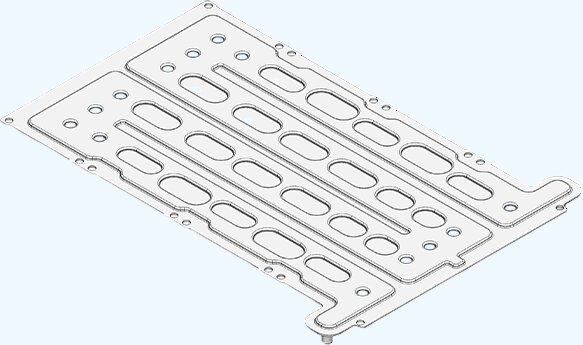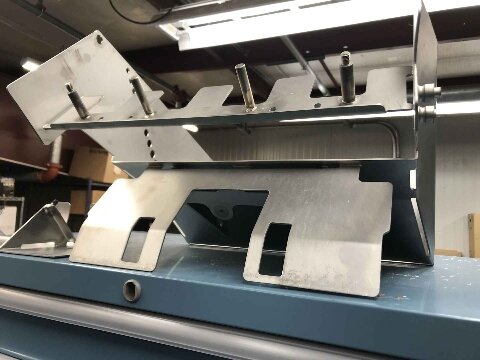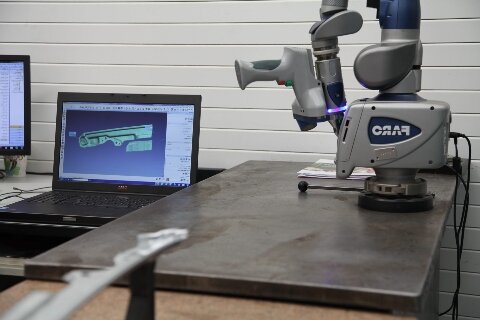스테인리스 스틸은 많은 산업 분야에서 널리 사용되지만 효과적으로 절단하려면 정밀도와 올바른 도구가 필요합니다. 깔끔하고 효율적인 절단에 어려움을 겪고 있다면 레이저 절단이 해결책이 될 수 있습니다. 레이저 커팅은 빠르고 정확한 결과를 제공하지만 작동 방식을 아는 것이 중요합니다.
레이저 커팅은 정밀도가 중요한 산업에서 널리 사용됩니다. 복잡한 디자인도 쉽게 처리할 수 있습니다. 레이저 커팅이 어떻게 작동하고 왜 그렇게 효율적인지 알아보겠습니다.
스테인리스 스틸 레이저 커팅이란?
레이저 커팅은 집중된 레이저 빔을 사용하여 스테인리스 스틸을 가열하고 녹여 매우 정확하게 절단할 수 있습니다. 레이저는 컴퓨터가 안내하는 경로를 따라 일관되고 반복 가능한 결과를 제공합니다.
이 방법은 복잡한 모양과 섬세한 디테일을 만드는 데 이상적이며, 열에 의한 왜곡을 최소화하면서 가장자리를 깔끔하게 만들 수 있습니다. 레이저 커팅은 재료에 물리적으로 닿지 않으므로 도구의 마모를 줄이고 효율적이고 정밀한 공정을 보장합니다.
레이저 커팅 시스템의 주요 구성 요소
레이저 커팅 시스템에는 깨끗하고 정확한 커팅을 생성하는 몇 가지 핵심 구성 요소가 있습니다.
레이저 소스
레이저 소스는 절단에 사용되는 집중된 광선을 생성합니다. CO2 또는 파이버 레이저로 구동할 수 있으며, 재료와 절단 요구 사항에 따라 각기 다른 이점을 제공합니다.
커팅 헤드
커팅 헤드는 레이저 렌즈를 고정하고 레이저 빔을 재료에 집중시킵니다. 스테인리스 스틸을 절단하는 데 필요한 곳에 레이저 빔을 정확하게 전달하는 역할을 합니다. 또한 커팅 헤드는 재료를 따라 움직이며 절단 경로를 따라갑니다.
CNC 제어 시스템
CNC 시스템은 레이저 커팅기의 움직임을 제어합니다. 디자인 파일을 해석하고 커팅 헤드를 올바른 경로로 안내합니다. 또한 CNC 시스템은 재료의 두께와 유형에 따라 레이저의 강도와 속도를 조정하여 절단 공정을 최적화합니다.
스테인레스 스틸을 레이저로 절단하는 방법은 무엇입니까?
스테인리스 스틸 레이저 절단은 정해진 경로를 따라 재료를 녹이거나 기화시키는 고출력 레이저 빔으로 시작됩니다. 절단 과정은 컴퓨터 프로그램에 의해 제어되며, 레이저가 설계에 따라 움직이도록 안내합니다.
스테인리스 스틸은 일반적으로 평평한 표면에 놓고 산소나 질소와 같은 가스가 절단 부위에서 용융된 금속을 날려 보내 절단을 돕습니다. 이를 통해 열 왜곡을 최소화하면서 정밀하고 매끄럽게 절단할 수 있습니다.
레이저 커팅 공정의 주요 단계
레이저 커팅 프로세스에는 원하는 결과를 보장하기 위한 몇 가지 주요 단계가 포함됩니다.
재료 선택
재료의 두께, 등급, 표면 마감은 모두 최적의 절단 매개변수를 결정하는 데 중요한 역할을 합니다. 표면이 매끄럽고 두께가 균일한 스테인리스 스틸은 절단하기 쉬우므로 절단 품질이 향상됩니다.
설정 및 구성
커팅을 시작하기 전에 기계를 올바르게 설정해야 합니다. 여기에는 레이저의 출력 설정, 절단 속도 및 가스 흐름 조정이 포함됩니다.
절단 및 냉각
설정이 완료되면 레이저 절단기가 프로세스를 시작합니다. 레이저가 프로그래밍된 경로를 따라 재료를 녹이고 냉각 가스가 스테인리스 스틸이 과열되거나 뒤틀리는 것을 방지합니다.
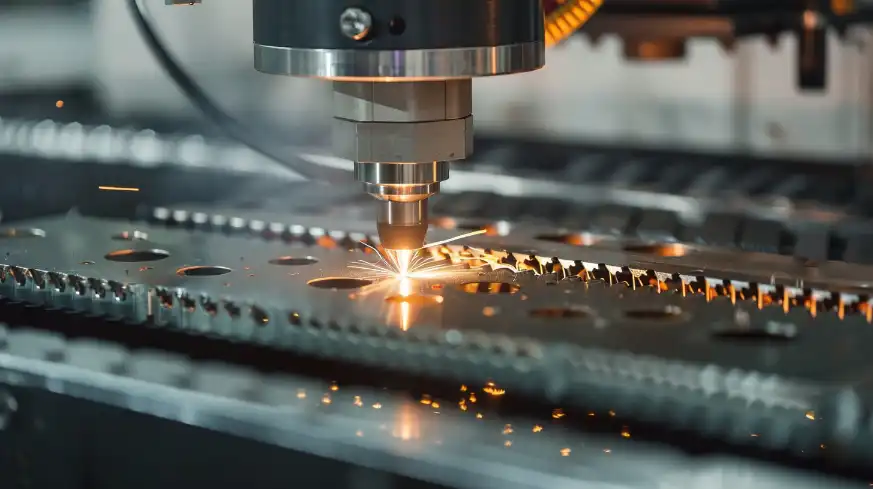
스테인리스 스틸 절단에 사용되는 레이저의 종류
스테인리스 스틸 절단에 일반적으로 사용되는 레이저에는 크게 두 가지 유형이 있습니다: CO2 레이저와 파이버 레이저입니다.
CO2 레이저
CO2 레이저는 두꺼운 스테인리스 스틸 소재를 절단하는 데 이상적인 가스 기반 레이저입니다. 파장이 더 길고 스테인리스 스틸을 포함한 다양한 금속을 고품질로 절단할 수 있습니다. CO2 레이저는 빔 품질이 우수하지만 시스템이 더 크고 비싸다는 단점이 있습니다.
파이버 레이저
파이버 레이저는 광섬유 케이블을 통해 빛을 전송하는 고체 상태의 레이저입니다. 효율적이고 컴팩트하며 스테인리스 스틸을 고정밀로 절단할 수 있는 것으로 잘 알려져 있습니다. 특히 더 얇은 재료에 효과적이며 CO2 레이저보다 운영 비용이 저렴합니다.
스테인리스 스틸 레이저 절단에 영향을 미치는 요인
스테인리스 스틸 레이저 절단에는 몇 가지 주요 요소가 영향을 미칩니다. 최상의 결과를 얻으려면 이러한 요소를 이해하는 것이 중요합니다.
재료 두께
두꺼운 재료는 깔끔한 절단을 위해 더 많은 레이저 출력과 느린 절단 속도가 필요합니다. 얇은 소재의 경우 더 빠르고 적은 전력을 사용합니다.
두께가 증가할수록 재료를 녹이는 데 더 많은 에너지가 필요합니다. 이로 인해 절단 시간이 길어지고 비용이 높아질 수 있습니다.
레이저 출력 및 속도
레이저 출력과 절단 속도는 균형을 맞춰야 합니다. 출력이 높으면 절단 속도가 빨라질 수 있지만 가장자리가 거칠어지거나 과도한 열이 발생할 수도 있습니다. 이러한 열은 재료를 왜곡할 수 있습니다.
절단 속도가 느리면 특히 세밀한 디자인의 경우 정밀도가 향상될 수 있습니다. 하지만 속도가 느리면 열에 영향을 받는 부분의 위험도 높아질 수 있습니다.
절단 가스 선택
올바른 절단 가스를 선택하는 것도 중요합니다. 산소 및 질소와 같은 가스가 일반적으로 사용되며, 각각 다른 효과를 가지고 있습니다.
산소는 더 빨리 절단되지만 가장자리가 거칠어질 수 있습니다. 질소는 가장자리가 더 매끄럽고 깔끔하게 절단되지만 속도가 느리고 비용이 더 많이 듭니다.
최첨단 품질 및 허용 오차
커팅 엣지의 품질은 여러 요인에 따라 달라집니다. 여기에는 레이저 출력, 절단 속도, 재료 두께 등이 포함됩니다. 레이저 커팅은 일반적으로 최소한의 버로 깔끔한 모서리를 만들지만, 과도한 열은 마감을 거칠게 만들거나 뒤틀림을 유발할 수 있습니다.
엄격한 허용 오차도 필수입니다. 특히 중요한 부품의 경우 정밀도가 필수인 경우도 있습니다. 적절한 기계 설정과 미세 조정을 통해 엄격한 공차와 고품질 절삭을 유지할 수 있습니다.
스테인리스 스틸 레이저 커팅의 장점
레이저 커팅 스테인리스 스틸은 다양한 이점을 제공하므로 많은 산업 분야에서 선호되는 방법입니다. 레이저 절단이 다음과 같은 경우에 탁월한 선택이 되는 주요 이점은 다음과 같습니다. 스테인리스 스틸 제작.
정밀도와 정확성
레이저 커팅은 정확성으로 잘 알려져 있습니다. 레이저 빔은 복잡한 패턴과 미세한 디테일을 매우 정밀하게 절단할 수 있습니다. 또한 기존의 절단 방법으로는 달성하기 어려운 엄격한 공차를 달성할 수 있습니다.
속도와 효율성
레이저 커팅은 빠르고 효율적인 프로세스입니다. 정확성을 잃지 않고 많은 생산량을 처리할 수 있습니다. 이 기계는 절단 사이에 중단 시간이 거의 없이 연속적으로 절단하므로 소규모 및 대규모 생산 모두에 비용 효율적입니다.
복잡한 모양과 디자인을 자르는 기능
레이저 커팅의 가장 큰 장점은 복잡한 모양과 디자인을 쉽게 커팅할 수 있다는 점입니다. 날카로운 각도, 곡선, 세밀한 구멍 등 레이저 커팅은 특별한 도구 없이도 어떤 디자인이든 따라갈 수 있습니다.
깔끔한 모서리와 고품질 마감
레이저 커팅은 깔끔한 가장자리와 고품질 마감을 제공하여 추가 가공의 필요성을 줄여줍니다. 레이저 빔은 재료를 정밀하게 녹이거나 기화시켜 매끄럽고 버가 없는 가장자리를 남깁니다.
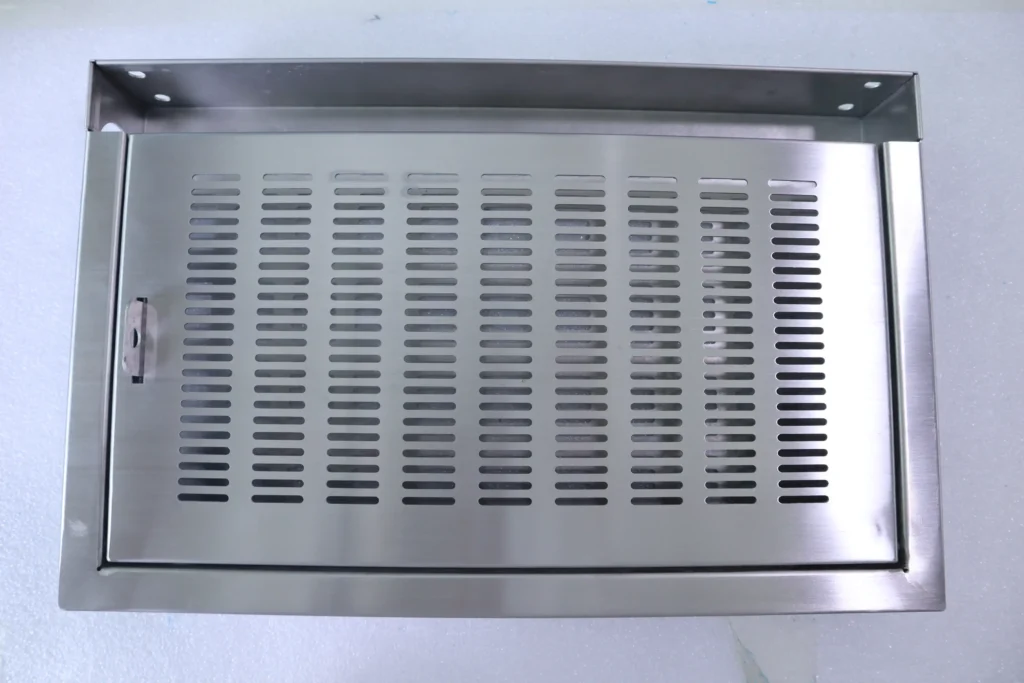
스테인리스 스틸 레이저 커팅의 과제와 솔루션
스테인리스 스틸 레이저 커팅에는 많은 이점이 있지만 몇 가지 문제도 있습니다. 다음은 최상의 결과를 얻는 데 도움이 되는 몇 가지 일반적인 문제와 가능한 해결책입니다.
머티리얼 변형 및 뒤틀림
스테인리스 스틸 레이저 커팅의 한 가지 문제는 재료 변형과 뒤틀림의 위험입니다. 레이저의 열로 인해 재료가 불균일하게 팽창 및 수축하여 가장자리가 뒤틀릴 수 있습니다.
해결책: 뒤틀림을 줄이려면 절단 속도와 레이저 출력을 조정하세요. 공기나 질소 등의 냉각 방법을 사용하면 온도를 관리하고 열 축적을 방지하는 데 도움이 될 수 있습니다.
비용 고려 사항
레이저 커팅은 특히 고출력 레이저를 사용하거나 두꺼운 재료를 절단할 때 기존 방법보다 비용이 더 많이 들 수 있습니다. 기계 비용, 에너지 소비량, 질소나 산소 같은 가스 때문에 일부 프로젝트에서는 비용이 더 많이 들 수 있습니다.
해결책: 제조업체는 비용을 절감하기 위해 절단 매개변수를 최적화하여 효율성을 개선할 수 있습니다. 레이저 절단은 설치 비용이 여러 부품에 분산되므로 대규모 생산에 가장 비용 효율적입니다.
두께 제한
레이저 커팅은 얇은 스테인리스 스틸에는 잘 작동하지만, 재료 두께가 두꺼워질수록 공정이 느려지고 어려워집니다. 두꺼운 스테인리스 스틸을 절단하려면 더 높은 레이저 출력이 필요하므로 절단 시간과 열 입력이 증가합니다.
해결책: 절단 속도와 레이저 출력과 같은 매개변수를 조정하면 두꺼운 재료로 작업할 때 효율성과 품질을 유지하는 데 도움이 될 수 있습니다. 고출력 파이버 레이저는 두꺼운 스테인리스 스틸에 더 나은 성능을 제공하기 때문에 특히 효과적입니다.
표면 마감 문제
레이저 커팅은 일반적으로 가장자리를 깔끔하게 만들지만, 특히 두꺼운 소재의 경우 표면 마감 문제가 발생할 수 있습니다. 과도한 열은 산화, 거친 가장자리 또는 버최종 제품의 품질에 영향을 미치는 요소입니다.
해결책: 질소를 절단 가스로 사용하여 표면 마감을 개선합니다. 질소는 산화를 방지하고 더 깨끗한 커팅을 만듭니다. 절단 속도와 레이저 출력을 조정하면 열 영향을 받는 부분을 최소화하고 마감 품질을 향상시킬 수 있습니다.
레이저 커팅 스테인리스 스틸의 응용 분야
레이저 절단은 정밀도, 속도, 다용도성을 제공하기 때문에 다양한 산업 분야에서 널리 사용됩니다. 다음은 스테인리스 스틸의 레이저 절단이 중요한 몇 가지 주요 분야입니다.
항공우주산업
항공우주 분야에서 스테인리스 스틸 부품은 강도와 정밀도에 대한 엄격한 기준을 충족해야 합니다. 레이저 절단은 구조물과 같은 복잡한 부품을 생산하는 데 적합합니다. 프레임, 괄호, 그리고 인클로저.
자동차 제조
레이저 커팅은 자동차 제조에서 섀시, 엔진 부품, 차체 패널과 같은 부품을 생산하는 데 널리 사용됩니다. 이 방법을 사용하면 자동차 분야에 필수적인 복잡한 디자인, 경량 부품 및 매끄러운 마감을 구현할 수 있습니다.
의료기기 생산
스테인리스 스틸은 의료 기기 산업에서 수술 기구, 임플란트 및 진단 장비와 같은 부품에 사용됩니다. 레이저 커팅은 이러한 섬세하고 복잡한 부품에 필요한 정밀도를 제공합니다.
건축
레이저 커팅은 일반적으로 건축 업계에서 장식용 금속 패널, 파사드 및 맞춤형 기능을 만드는 데 사용됩니다. 스테인리스 스틸의 내구성과 미적 매력은 레이저 커팅의 정밀함과 결합되어 기능적, 예술적 응용 분야에 탁월한 선택이 될 수 있습니다.
결론
레이저 커팅 스테인리스 스틸은 항공우주 및 소비재 산업에 정밀성, 속도, 다용도성을 제공합니다. 깔끔한 절단, 최소한의 마감 처리, 복잡한 디자인을 처리할 수 있어 프로토타입 및 대량 생산에 적합한 비용 효율적인 솔루션입니다.
고품질 레이저 커팅 스테인리스 스틸 부품이 필요하신가요? 오늘 빠른 견적 받기! 전문가가 고객의 특정 요구에 맞게 디자인, 재료 및 비용을 최적화할 수 있도록 도와드립니다.
자주 묻는 질문
스테인리스강 레이저 절단에는 어떤 가스가 사용됩니까?
스테인리스 스틸 레이저 절단에 가장 일반적으로 사용되는 가스는 산소, 질소, 공기입니다. 산소는 빠른 절단에 사용되며 약간 거친 가장자리를 생성하고 질소는 더 깨끗하고 매끄러운 절단을 제공하지만 속도는 느립니다. 공기는 비용 효율적인 옵션으로 더 얇은 재료에 사용되기도 합니다.
스테인리스 스틸에 가장 적합한 레이저는 무엇인가요?
스테인리스 스틸 절단에 가장 적합한 레이저는 파이버 레이저입니다. 파이버 레이저는 효율적이고 절단 속도가 빠르며 열 왜곡을 최소화하면서 고품질의 절단을 생성합니다. 특히 더 얇은 스테인리스 스틸 절단에 효과적이며 CO2 레이저보다 운영 비용이 저렴합니다.
레이저 절단이 가능한 강철의 최대 두께는 얼마입니까?
레이저로 절단할 수 있는 스테인리스 스틸의 최대 두께는 레이저의 출력과 재료의 종류에 따라 다릅니다. 일반적으로 파이버 레이저는 최대 20mm 두께의 스테인리스 스틸을 절단할 수 있고, CO2 레이저는 최대 25mm 두께의 재료를 절단할 수 있습니다.
스테인레스 스틸을 레이저로 절단하는 데 비용이 얼마나 드나요?
스테인리스 스틸 레이저 절단 비용은 재료 두께, 레이저 출력, 절단 속도, 디자인 복잡성에 따라 달라집니다. 평균적으로 비용은 절단 분당 $0.50~$2.00이며, 재료가 두껍거나 복잡한 절단일수록 가격이 높아집니다.
추가 자료:
레이저의 종류 – 출처 : Laserax
파이버 레이저의 장점 – 출처 : Findlight
안녕하세요, 저는 케빈 리입니다

지난 10년 동안 저는 다양한 형태의 판금 제작에 몰두해 왔으며 다양한 워크숍에서 얻은 경험에서 얻은 멋진 통찰력을 이곳에서 공유했습니다.
연락하세요

케빈 리
저는 레이저 절단, 굽힘, 용접 및 표면 처리 기술을 전문으로 하는 판금 제조 분야에서 10년 이상의 전문 경험을 갖고 있습니다. Shengen의 기술 이사로서 저는 복잡한 제조 문제를 해결하고 각 프로젝트에서 혁신과 품질을 주도하는 데 최선을 다하고 있습니다.

